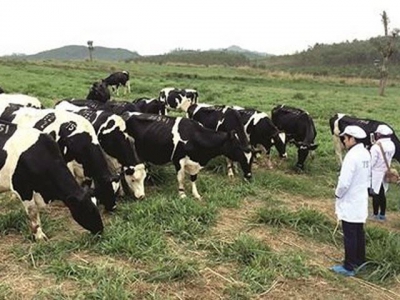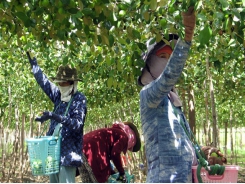Solutions for achievement of agricultural export target

Vietnam's agricultural export turnover reached a record level of about US$40 billion last year, ranked second in Southeast Asia and 15th in the world with products being exported to more than 180 countries and territories.
Dairy cows of TH Group are kept extensively. (Photo: SGGP)
This year, agricultural industry aims to achieve above $43 billion in exports and is expected to face several challenges amid the context of the trade war between the US and China and more technical barriers to farm produce.
Agriculture posted the highest growth last year and had more new markets with many key products. According to the Ministry of Agriculture and Rural Development, the industry’s total export turnover increased 9.6 percent compared to that in 2017, of which farm produce exports hit $19.51 billion, up 1.4 percent; aquatic products exports reached $9.01 billion, up 8.5 percent; and wood and forestry products exports touched $9.34 billion, up 15.7 percent.
The industry continued to maintain ten items with export turnover above $1 billion. Of which, five products whose export turnovers were above $3 billion consisted of wood and wooden products with $8.86 billion, shrimps with 3.59 billion, vegetables and fruits with $3.81 billion, coffee with $3.46 billion and cashew nuts with $3.43 billion.
According to the Vietnam’s Fruit and Vegetables Association, yield of key farm produce greatly increased, meeting domestic consumption demand and increasing export, thanks to the use of high quality seeds, changes in structure of key products in accordance with market demand, development of science and technology combined with application of advanced production process and value-added production.
According to the Ministry of Agriculture and Rural Development, last year, an area of 105,000 hectares of paddy fields that give poor productivity had been converted to land used for growing fruit trees and vegetables. Although the area of paddy fields dropped, production still rose by 1.24 million tons. The area of fruit trees increased by 26,100 hectares and fruit production surged 300,000 tons compared to 2017. The quality and production of various kinds of vegetables also improved.
Aquatic industry prolonged its success with production of 7.75 million tons, up 6.1 percent, of which, fishing accounted for 3.6 million tons, up 5.3 percent and farming accounted for 4.15 million tons, up 6.7 percent.
According to the Vietnam Association of Seafood Exporters and Producers, export turnover rose 6 percent compared to 2017. Noticeably, pangasius fish raked in $2.3 billion, up 26 percent. Main seafood export markets included the EU, South Korea and the US. Despite the EU’s IUU yellow card, aquatic industry still showed great performance with steady growth.
At the meeting on organizing the implementation of seafood export plan for 2019 which was held recently, agricultural minister Nguyen Xuan Cuong said that this was a successful year of the country in aquatic farming thanks to science and technology application, market regulation and governance, hereby achieving market value.
At the same time, aquaculture has reached a turning point in completing from governance to production and from organizing export products to processing.
Although an export target of $10 billion is pretty high, it is reasonable. This year, the industry has to maintain exports of shrimps at $4.2 billion, pangasius fish at $2.3 billion and aquatic products at $3.5 billion.
Export expanded successfully thanks to the development of agro-forestry-aquatic processing industry. There were 16 modern fruit, vegetables, pork and poultry meat processing plants built and inaugurated last year.
Noticeably, animal husbandry industry has changed in the direction of industrial and semi-industrial farming. Total production of pigs was 5.36 million tons, up 3.2 percent compared to 2017. Some livestock products have been exported such as frozen pork to Myanmar and chicken to Japan.
Representative of the Agro Processing and Market Development Authority said that in order to achieve this year’s export plan of $43 billion, in the first months of this year, the Ministry of Agriculture and Rural Development has continuously held several meetings to discuss on solutions to support the development of each industry. This year, the ministry will also promote negotiation to add more products to the list of export products to China. Besides, firms and farmers should change their farming methods.
The industry should continue restructuring and promote production, processing, market developing and sustainable growth as well as recheck and evaluate advantages and potentials so as to build product structure that is suitable with market demand.
‘If you want to go fast, go alone; if you want to go far, go together’, quoted Mr. Dang Phuc Nguyen, general secretary of the Vietnam’s Fruit and Vegetables Association. According to him, if the industry wants to complete its target, it should increase production and quality. In order to do that, farmers have to collaborate to establish cooperatives to implement advanced farming process together. The Government should have policy to help enterprises to build processing plants to make the most of raw material area. Hereby, Vietnamese agriculture is able to gain foreign consumers’ trust to boost export.
Mr. Ngo Van Ich, VASEP’s chairman, said that the association and the ministry along with firms will take action to improve issues on illegal, unreported and unregulated fishing to remove the EU’s yellow card.
The aquaculture should focus on ending issues on chemical residues and diseases in shrimps, taking advantage of the free trade agreement between Vietnam and the EU to increase export into European countries and increasing import of legal selective raw materials for processing in order to get high value.
According to the ministry, solutions should be implemented to get the most out of the industrial revolution in processing and preserving technology to reduce losses. The industry should maintain traditional markets, expand export to new markets and should not neglect domestic market. There should be synchronization in farming and technology upgrade in processing so as to lower cost prices and extend the value chain.
Có thể bạn quan tâm
Phần mềm

Phối trộn thức ăn chăn nuôi

Pha dung dịch thủy canh

Định mức cho tôm ăn

Phối trộn phân bón NPK

Xác định tỷ lệ tôm sống

Chuyển đổi đơn vị phân bón

Xác định công suất sục khí

Chuyển đổi đơn vị tôm

Tính diện tích nhà kính

Tính thể tích ao hồ



 Canada protects two Vietnamese brands
Canada protects two Vietnamese brands  Bac Giang has three typical agriculture products
Bac Giang has three typical agriculture products